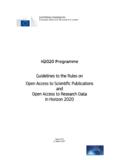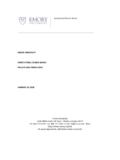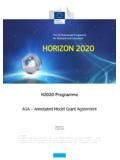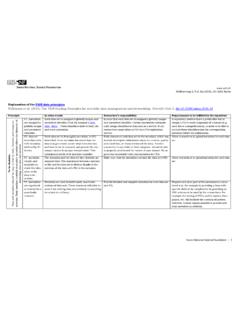Transcription of Open Access Strategies in the European Research Area
1 Open Access Strategies in the European Research Area August 2013 Julie Caruso, Aurore Nicol & Eric Archambault Open Access Strategies in the European Research Area August 2013 Produced for theEuropean Commission DG Research & InnovationRTD-B6-PP-2011-2: Study to develop a set of indicators to measure open Access The views expressed in this report are those of the authors and do not necessarily represent the views of the European Commission by Science-Metrix | Montreal | Washington1335 Mont-Royal E., Montr al Qu bec, Canada, H2J 1Y6 image: iStockphoto Open Access Strategies in the European Research Area August 2013 i Produced for the European Commission DG Research & Innovation Executive Summary This report presents an overview and analysis of Strategies towards open Access (OA) of peer-reviewed publications in the European Research Area (ERA), Brazil, Canada, Japan and the US from the year 2000 onwards.
2 The analysis examines Strategies that aim to foster OA ( researcher and institutional incentives) and discusses how OA policies are monitored and enforced. The analysis is supported by findings from the literature on the global progression of OA since 2000, and comments on themes and debates that have emerged from the movement. Governmental OA Strategies Most national governments have not proposed or implemented direct legislation on OA. Instead, OA is often addressed through less formal means, such as the production of guidelines for Research funding agencies. Related legislation often includes laws on copyright and licensing; in fact, all countries covered in this study with the exception of Cyprus have copyright legislation that may apply to peer-reviewed publications.
3 Legislation directly addressing OA has been proposed in the US and Brazil. In the US, the Consolidated Appropriations Act 2008, is the legislative basis for the OA policy of the National Institutes of Health (NIH). With this legislation, the US became the first country to adopt a national OA mandate. The Fair Access to Science and Technology Research Act (FASTR), introduced in Congress in February 2013, would require all federal agencies with extramural Research expenditures of over $100 million to develop a federal Research public Access policy. In Brazil, a bill (PL 1120/2007) was introduced in May 2007 proposing that all public institutions of higher education and Research units be required to establish institutional repositories .
4 However, the bill was archived in January 2012. A number of countries in the ERA have instituted national policies, programmes and principles related to OA. The UK is a leader in the development of OA to peer-reviewed publications, with the Higher Education Funding Council for England (HEFCE) and the Research Councils UK (RCUK) pushing for greater public Access to publicly supported Research , as well as the considerable influence of Jisc, a UK registered charity that aims to champion the use of digital technologies in UK education and Research . The 2013 Policy on Open Access , drafted by the Working Group on Expanding Access to Published Research Findings, will make all government-funded Research OA within five years, with a target of 45% in the first year.
5 In Ireland, the National Principles for Open Access Policy Statement (2012) mandates the deposit of outputs of funded Research in OA repositories . Since 2006, Sweden has had a national OA programme, , which has played a role in the creation of a national search portal for scholarly publications (SwePub), the Directory of Open Access Journals (DOAJ), and a number of institutional and funder policies. France's HAL multi-disciplinary open archive was launched by the Centre National de la Recherche Scientifique (CNRS) in 2001. At the pan- European level, the Open Access Pilot was launched by the European Commission as part of its Seventh Framework Programme (FP7) in August 2008.
6 Within several thematic areas of the framework programme, FP7 projects are required to deposit peer-reviewed Research articles or final manuscripts resulting from projects into an online repository. Other Europe-wide initiatives include the Digital Repository Infrastructure Vision for European Research (DRIVER), established to build a cohesive network of repositories for Research and education, and the Open Access Infrastructure for Research in Europe (OpenAIRE), a complementary project offering organisational and technological infrastructure for the identification, deposition, Access and monitoring of FP7 and European Research Council (ERC) funded publications.
7 Open Access Strategies in the European Research Area August 2013 ii Produced for the European Commission DG Research & Innovation At the international level, Research performing organisations also contribute to the global spread of OA. Since 2010, much of the World Bank's Research has been made available to the public through its website and with the Open Data Initiative and Access to Information Policy. Furthermore, its new OA policy, effective since July 1, 2012, adopts the Creative Commons Attribution (CC-BY) copyright licence for all of its outputs and other knowledge products, solidifying the World Bank's position as a forerunner in OA.
8 Funding Bodies' Policies and Mandates An analysis of funding bodies' OA policies was performed using data from JULIET, as well as BioMed Central (Funder Policies), ROARMAP and MELIBEA. The goal of this analysis was to assess the extensiveness of OA policies as well as to examine OA rules for grant recipients, across ERA countries and in Brazil, Canada, Japan and the US. The country with the highest number of OA policies is the UK (with 15 mandates), followed by Canada (13), the US (4), Ireland (4) and Spain (3). No funder mandates could be found for the other examined countries (Brazil, Bulgaria, Croatia, Cyprus, Czech Republic, Estonia, Finland, Germany, Greece, Iceland, Latvia, Luxembourg, Malta, the Netherlands, Romania, Slovakia, the Former Yugoslav Republic of Macedonia, Liechtenstein, Lithuania, Poland, Portugal, and Slovenia).
9 All in all, the number of policies alone is a weak indicator of commitment to OA in a given country. An analysis of the 48 currently implemented funder policies in the countries was conducted and startling inequalities were found in the level of detail provided. Funding agencies that are building a new OA policy or renewing a pre-existing policy should consider a number of key points for transparency. Among these are: Coverage of article processing charges (APCs): of funders indicated that they would cover the APCs, and indicated that they would not. The remaining of policies did not specify whether they would pay the fees. Preference for green or gold OA: None of the funder policies favoured gold OA, favoured green, 2% mandated both green and gold, and 58% expressed no preference.
10 If green OA is allowed, specific repositories may be identified. Acceptable types of documents and metadata: 79% of policies specified that articles should be deposited in their final accepted version or post-print. Project scope: Guidelines must clarify at what point the policy applies with respect to a certain percentage of funding provided or the number of authors who are grantees. Embargoes: If the policy supports green OA, embargoes may be accepted to give publishers exclusivity for a limited time. Among the 48 funder policies reviewed, 77% accepted embargoes between 6 and 12 months. Compliance with policy is seldom tracked or reported.







